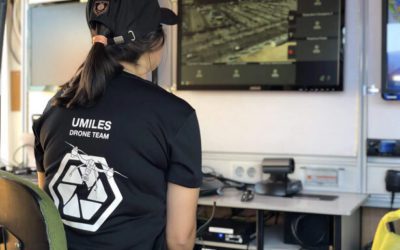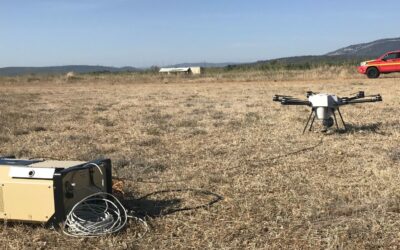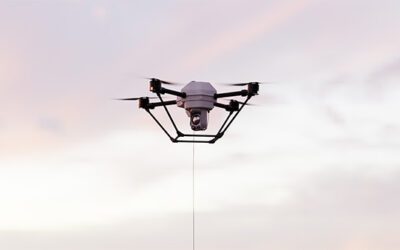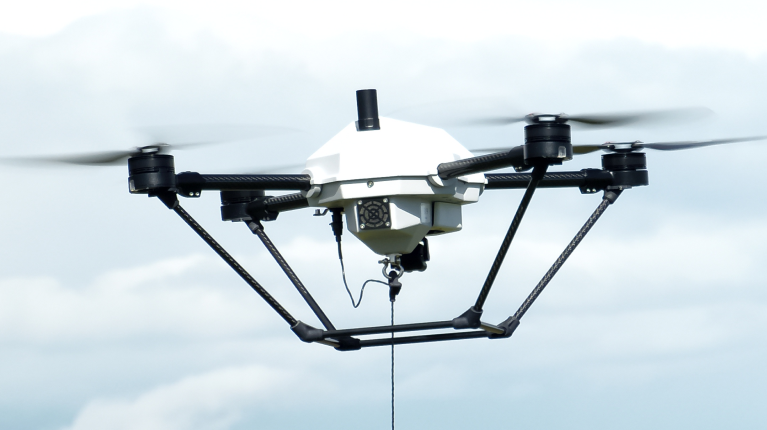Tethered Drones in the New European Regulation
Mate P.
11 minutes
Part 1 – New European regulation on drones: goals and classification
In 2019, two new regulation were adopted by the European Commission on the provisions related to operations with unmanned aircrafts [1] (the UAs, hereinafter drones) and to marketing thereof [2].
The long-awaited legal acts brought uniform rules for all operators and for the drone manufacturers all over the European Union, and from 2021, this can further boost the industry, which is already facing great demand amid Covid-19 pandemic.
The biggest advantage of the new regulation is that it has a general risk-based approach that makes it possible to handle several different operations of drones under the same legal regime, but this makes it very complex at the same time.
In this part, the structure of drone operation regulation will be examined by naming the most important parts that are relevant from the point of view of tethered drones.
The categories of operations
In general, the EU distinguishes three main operational categories: OPEN, SPECIFIC and CERTIFIED.
The OPEN category sets the fewest requirements against operators but limits capabilities of the unmanned aircraft system (UAS that includes the drone itself and the remote control) the most at the same time.
There is no need for any permit to fly as long as restricted airspace and No-Drone Zones are respected and avoided. The maximum altitude of the drone may not exceed 120 meter above ground level and the drone may not weigh more than 25 kg.
It must be kept within the visual line of sight (VLOS) of the remote pilot during the whole operation. Fly over assemblies, carrying dangerous goods or dropping anything from the drones are also porhibited of the OPEN category.

This category of UAS operations is further divided into three subcategories (A1, A2 and A3).
In A1 only drones under 900 gr of maximum take-off mass (MTOM) are allowed to operate (UA class C0 and C1). In this subcategory, the drone might fly over other people but it must do this as quickly as possible.
In A2 subcategory where the MTOM limit is 4 kg, a minimum distance of 30 meters from other persons must be kept.
A3 subcategory is for the larger drones with MTOM up to 25 kg, but these drones must not fly closer than 150 meter to inhabited and industrial areas.
SPECIFIC category (where the concept of operation exceed the limits of the OPEN category), the operator of the UAS is obliged to pursue a risk assessment, if he wants to acquire an operational authorisation. To this assessment, the EU provides the so-called SORA (Specific Operations Risk Assessment) as supporting material.
CERTIFIED category is basically including three main types of operations: transporting passengers, flying over assembly of people and carrying dangerous goods that pose great risk to environment in case of accident. The detailed rules in this category are yet to be elaborated, but the EU has a strong intent to solve the complete integration of all drones into the manned air traffic via U-Space, which means that this category of UAS operations will be also important in the future.
The unmanned aircraft classes
The EU regulations introduced technical requirements to drones beside operational ones. These requirements are sorted into different UA classes ranging from C0 to C6. These UA classes are important because each represent a different level of technical equipment and maximum take-off mass so defining which drone is suitable for which operations.
The UA class is indicated by class identification label that must be attached to the drone. The class identification label helps consumers choose a drone fitting to their expectations. But in order to have this label on the drone, the UAS shall go through a conformity assessment procedure. This procedure might be pursued by the manufacturer (C0 and C4-C6) upon a harmonised community standard or by a notified body (for all UA classes).
The UA classes – together with the intended type of operation – also determine what kind of remote pilot competency is required and what theoretical and practical knowledge the remote pilot should have.
In OPEN category C0 to C4 classes are allowed to operate, while C5 and C6 classes are for special operational categories called standard scenarios. These scenarios are between OPEN and SPECIFIC category in terms of risk and complexity as the MTOM of the drone may not reach 25 kg but – in certain conditions – operations beyond visual line of sight (BVLOS) are permitted.
In case if an operator decides to operate according to any of these scenarios the right to operate can be acquired in a simpler way than in SPECIFIC category, because the use of standard scenarios supplements the necessity of risk assessment.
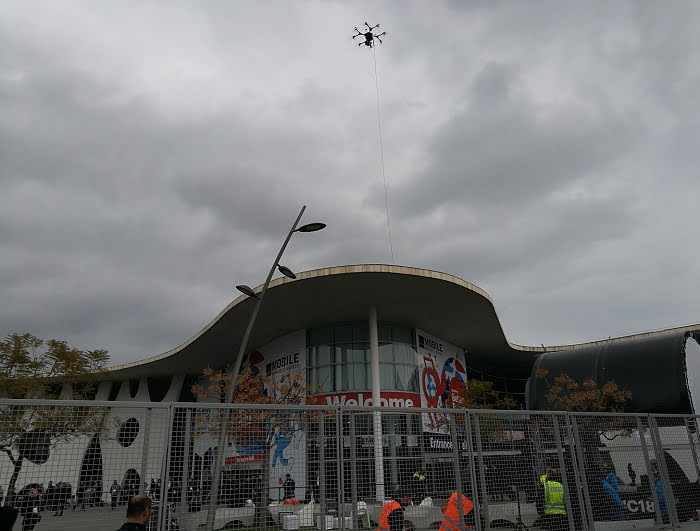
As the introduction of UA classes and conformity assessment means a sever modification to many drones currently available on the market, the manufacturers were granted a two year transitional period to prepare for the conformity assessment. This transitional period is important for regulators too, because the above mentioned harmonised standard is not finished yet, and no notified body has been established until now.
From 1st January 2023 only drones with class identification label will be allowed to be put on the market for OPEN category and rules related to UA classes will be fully applicable from that day only.
Tethered drones in OPEN category
Besides operations and classes, drones can be sorted into categories based on their structures too. Fixed wing or multirotor drones and so-called tethered drones can also be distinguished. In UA class C2-C3 the EU determined certain technical specifications for tethered drones.
In case of a tethered drone the most important part of the UAS is the tether that must meet technical requirements. Both in UA class C2 (MTOM up to 4 kg) and C3 (MTOM less than 25 kg) the tether shall have a tensile length of less than 50 meters and a mechanical strength that is no less than 10 times the weight of the aerodyne at maximum mass.
If the UA is lighter than air aircraft (e.g. balloon) the mechanical strength shall be 4 times the force exerted by the combination of the maximum static thrust and the aerodynamic force of the maximum allowed wind speed in flight.
Tethered drones in standard scenarios
Tethered C5 class drones can fly in standard scenario (STS-01) operations, but their specifications are mainly based on C3 class and are far simpler than of non-tethered C5 drones. In case of tethered C5 drones, the core of safety is tether too and the area controlled by the operator has a radius equal to the tether length plus 5 m and centred on the point where the tether is fixed over the surface of the earth.
In the second part of the article, we are introducing the problems around the lack of notified bodies and the opportunities to operate tethered drones without class identification label.
Part 2 – The opportunities of tethered drones in the new European regulation
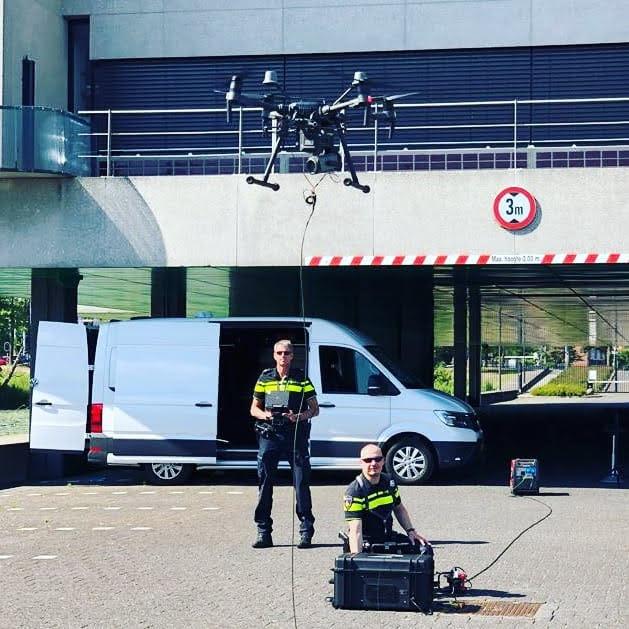
The first part was an overview of the new EU-wide drone-regulation. In this part we will go further and show the advantages of the tethered drones: they have to meet lower standards both in OPEN category and standard scenario operations in terms of either technical specifications or operational requirements (in the latter case the area that must be under control of the operator is far bigger if a non-tethered drone flies). And this is a clear advantage both for manufacturers and operators while the high standard of safety of air traffic is maintained.
The fact that only C2 and C3, C5 classes name tethered drones does not mean that tethered drones would be limited to OPEN category or standard scenarios: tethered drones without class identification label might be used in SPECIFIC category.
As tethered drones are frequently used for surveillance or over assemblies of people, which operations fall under SPECIFIC category according to the new EU regulation, the latter category of UAS operations grants numerous opportunities for UAS operators to deploy their tethered drones far beyond the limitations of the OPEN category.
The lack of conformity assessment
As it was mentioned in the first part, in the lack of harmonised community standards and notified bodies in member states, it is not possible to pursue conformity assessment. Due to this circumstance, no drone with class identification label is available on the market now.
Therefore, every drone with MTOM of 250 g or more can operate only at least 150 meters away from inhabited or industrial areas. If the operator wants to fly a drone closer to these areas, he shall request an operational authorisation because his operation will fall under the rules of SPECIFIC category.
In SPECIFIC category the risk assessment determines how dangerous the operation is and whether the operator has proper means to mitigate the risk of flying the drone.
In order to assess both the risks and mitigating measures the EU introduced SORA that – in its philosophy to cover as many kinds of operations as possible with one single system – follows the spirit of the new EU regulations. Why SORA is very important is that it provides help not only for the operators but also for the competent authorities, because – as said – the kinds of operations are numerous and this assessment method helps to uniform the risks and mitigating measure. Eventually this leads to faster decision making on the authorities’ sides and contributes to the commencement of UAS operations.
The Specific Operations Risk Assessment
SORA distinguishes different intrinsic ground risks and air risks that shall be mitigated by the operator through using different measures. It is not not enough to indicate these measures, they must be proven somehow at the same time. The more the mitigating effect of the measure is proven the lower the final risk class of the operation is.
Here come the advantages of tethered drones
For them SORA sets out different areas for mitigating ground risks in comparison with non-tethered drones. In case of latter ones, the operators shall provide mitigating measure for limiting or decreasing the number of uninvolved persons who might be endangered by the operation, and the extension of the ground risk buffer that surrounds the flight geography is essential too. The bigger the flight geography is, the bigger area shall be secured and monitored by the operator. This makes the operation more expensive.
At tethered drones – similarly to the technical rules of the UA classes C2, C3 and C5 – the design of the tether and procedures for the setup and maintenance thereof play crucial role when it comes to determining ground risks and mitigating measures. This also means that operator can concentrate its sources on maintenance instead of controlling a vast territory on the ground to be prepared for the loss of signal with the drone.
Advantages in the application of tethered drones
Most of modern drones are using electric power that makes batteries and their capacity vital for the maintenance of command and control over the drone.
In case of tethered drones, the tether makes it possible to provide constant supply of power and secure cable connection between the drone and its command unit. SORA appears at this point again, because all operators shall be prepared for unforeseen events and have an emergency response plan.
Making such a plan is much easier if the operator has the tether as an extra measure to mitigate the risk of loss of signal or low battery situations. The tethered drones can also be equipped with onboard batteries that – together with electricity supply via cable – provide a redundancy, which can extremely increase the safety of the flight.
Another advantage of operating tethered drones in comparison with non-tethered ones is that – according to SORA – a relatively low risk classification can be achieved by making only tests to prove the strength and safety of the tether system. If the operator chooses a manufacturer that makes a lot of test during the development phase of manufacturing this part of the assessment can be easily fulfilled.
From operator’s point of view, it is therefore essential to choose a product from a manufacturer that put sufficient emphasis on the development and have pursued the proper test program.
The tether further means an extra measure to prevent the drone from flying too high unintendedly, so mitigating the risks posed to other aircrafts. Tethered drones are built together with a ground unit that serves as a fixing point and that can winch the tether back. So the drone comes back to the ground once the operation is terminated.
As the tether provides direct and constant connection between the drone and the command unit, these UAS, when they are equipped with a follow-me capability can easily be set to vehicles to extend the area of operation as the drone will follow the vehicle on the ground and benefit from unlimited power supply with the tether. This capability already makes tethered drones attractive not only in the civil aviation but also in the military sector
To sum it up, the tethered drones have a lot of advantages as they are representing a safer kind of unmanned aviation and the tether means no barrier anymore but a potential for a wide range of application with easier to meet criteria – irrespective of the category of the operation.
REFERENCES
[1] Commission Implementing Regulation (EU) 2019/947 on the rules and procedures for the operation of unmanned aircraft
[2] Commission Delegated Regulation (EU) 2019/945 on unmanned aircraft systems and on third-country operators of unmanned aircraft systems
Author – Mate P.

